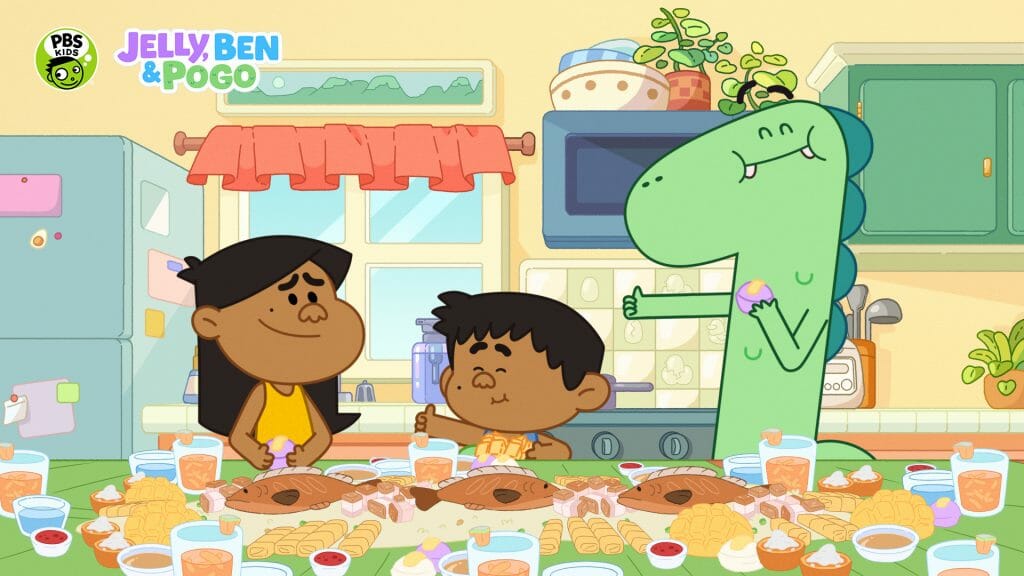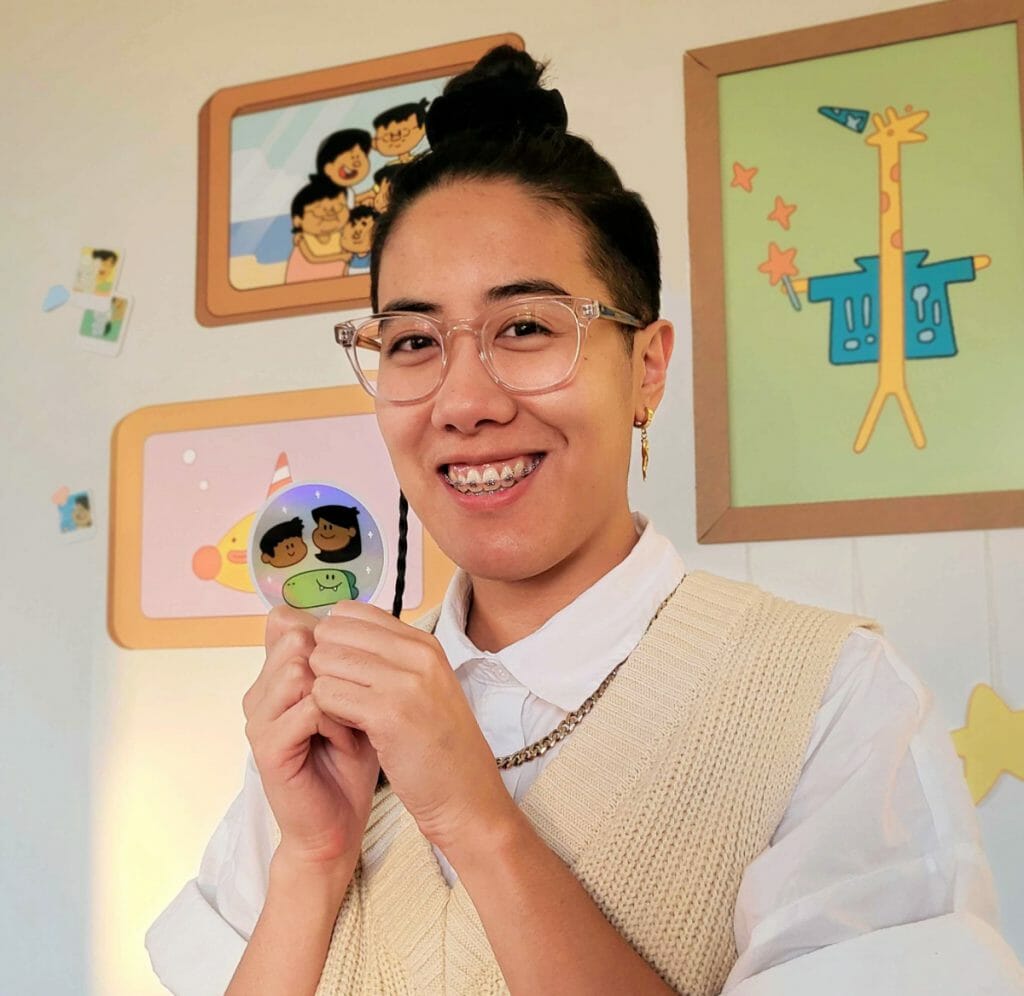Jelly, Ben & Pogo is an animated short series for PBS Kids that follows two friends, whose families are from The Philippines, as they grow up in America. Though the series does not shy away from being culturally specific, the stories will feel familiar to many children around the wold. Becoming good friends, the two kids, Jelly and Ben, team up with a friendly sea monster, Pogo, who accompanies them on all manner of quizzical adventures. These friends share stories that show the importance of learning, working together, and respecting elders; inspired by experiences growing up in Pinoy households.
Created by Jalysa Leva and her team at Primal Screen, Jelly, Ben & Pogo benefits from a charming visual style and endearing character design that make for an instantly lovable pre-K children’s show. This series features rigged characters and cutout animation made using Toon Boom Harmony.
We were eager to learn more about the process behind the show and how they assembled their tight-knit crew, and were lucky enough to interview Jalysa and the talented team at Primal Screen. Read on to hear who handled what on the project and to gain their valuable insights from the show’s production.
Please introduce Jelly, Ben & Pogo and tell us about how you came to create the lovable show!
Jalysa: Jelly, Ben & Pogo is a pre-k, animated shorts series on PBS KIDS that follows two Filipino siblings and their sea monster neighbor as they tackle everyday kid problems using empathy and creative design thinking. The target audience is children aged 4-6. And its main messages teach about social emotional learning, design thinking, and Filipino culture.
Can you introduce some of the team members and their roles on the show?
Jalysa: Joe Kubesheski, Animation Director: He kept the animation department a well-oiled machine by supervising and building the rigs, setting up Toon Boom files and their structure, critiquing animation, and so much more.
Linsey Kim, Art Director: She is responsible for the colorful and chunky look of Jelly, Ben & Pogo. Linsey supervised the background, prop, and character artists to keep the direction cohesive and extremely appealing.
Steve Mank, Writer & Sound Design: Steve helped get the concept of Jelly, Ben & Pogo solidified during development, before continuing on to help write episodes. He is also responsible for all sound design, including all the catchy tunes.
Laura Green Berry, Producer: Laura kept the boat chugging along by monitoring client relations and the overall health of the production.

Is there a backstory to the friendship? How did Jelly & Ben meet Pogo?
Jalysa: There’s definitely quite a bit of lore that lives in me and Steve’s heads about the trio that never made it to screen! The three met in their little town of Newberry; The location attracts all sorts of families, so Pogo’s family and Jelly’s family both moved there from different places. They bonded, probably in school, over the fact that they both are different and share an immigrant experience. Now they’re best buds and both sets of parents consider them all to be their collective children.
Can you describe the series’ setting?
Jalysa: It’s set in a fictional town somewhere in New England. This is why we have an episode on the beach, but also tons of snow sometimes! I grew up in Rochester, New York for a bit and wanted to include stories about the cold weather.
What are some of the ways you make the show feel distinctly Filipino?
Jalysa: There are so many ways the culture is both directly and subtly infused into the stories. I think that’s the beauty of true representation; it allows for details that really hit home that would otherwise be overlooked by people outside of the community. It ranges from the moles on Jelly and Ben’s cheeks, to having a full kamayan-style meal with traditional dishes. Regardless of how directly or indirectly we talked about culture, we wanted to make sure that it was from the perspective of Jelly and Ben’s family in order to normalize them. They’re never ‘the other,’ and if anything, Pogo is usually the one outside of the loop being invited in.

Can you tell me about the character design process of our three characters?
Jalysa: The trio were all designed by me! I have a private instagram where I would doodle almost daily for a while from my life. And the way I drew myself is basically how Jelly and Ben are approached. It’s just my natural default style!
As for Pogo, that all started with wanting to play with a flat-but-fun shape. The way her body scrunches and creates these rounded rectangles ended up being a driving visual motif across the show.
What are some of the interesting production techniques that went into the show’s unique style?
Joe: For Jelly, Ben & Pogo, we wanted a very traditional, hand drawn animation feel; not only in the animation itself, but in the overall feel of the series. Compositing techniques like cast shadows and depth of field needed to stay very subtle, if used at all, so they did not distract from the overall look and feel. When objects or characters did cast a shadow, we used animated masks drawn frame by frame; rather than relying on formula-driven compositing techniques. Most effects animation was hand drawn by the animators themselves in the scene, along with the character animation. This gives the effects animation a unified, immersive quality that feels more natural than adding effects in composite afterwards.
One story aspect of Jelly, Ben & Pogo that was challenging in the production pipeline was the many different outfits the characters wore throughout the series. Because visiting Pogo requires that Jelly and Ben go underwater, they had to have both a wetsuit and an above ground outfit; as well as fall and winter gear, and fun costumes for various occasions. Several variations on the rigs for Jelly, Ben, Lola and other characters had to be created; animation reuse from episode to episode was limited. While laying out each new episode, a combination of clever character design and good planning allowed us to adapt the rigs quickly prior to starting keys. We also held a weekly check in with the character animators, which gave everyone an opportunity to discuss problems with the rigs that needed ironing out globally. Or workarounds to circumnavigate problems.

The backgrounds in the show often change to accentuate the story. How did you achieve this technique?
Jalysa: The gradient ‘voids,’ as we call them, were highly inspired by Paprika on Netflix. That show is so stunning and their use of voids is so fun, we wanted to do something similar. We use them whenever we want to focus solely on the characters and their specific reactions or emotions in that moment. Certain patterns are used for certain moments.
As for their actual construction, the gradients were painted by Linsey in Photoshop, most flat patterns were made in Illustrator, and then they were combined in After Effects. Our compositors would usually do a first pass at generating the voids for an episode, and then I would go through and have them swap certain gradients or patterns out for different moments. It took a bit to figure out which patterns worked; but once we got a rhythm going, it was like having a kit to build from for each episode.
Linsey: The best way to describe the palette of Jelly, Ben & Pogo would be a fun, whimsical coloring book that combines playful pastels with more grounded earth colors.
What was the collaboration process between you and your team on the show?
Because we did everything in-house and with freelancers (no outsourcing), we had a very tight-knit crew. Since the entirety of production was remote due to COVID, we really prioritized constant and open communication. This meant a big general team weekly; where we would talk through the health of the production, as well as showcase work from every member. It eventually turned into the artists hyping each other up and paying close attention to work being done across all of the production.
On top of this, we would do workalongs where I’d run an open door Zoom for anyone to join on Thursdays to just work together. Folks could chit chat, ask questions, or share memes. We had a few channels on Slack for each department, but we also had a casual one where people could talk about their interests and again, share more memes! There would also be smaller department weeklies, as well as monthly 1-on-1s between me and every artist. It was a lot of talking, but it led to a team that was very collaborative and really unique ideas making it to the screen that I would have never thought of. I’m very thankful for how helpful everyone was to each other and how much easier it made getting through such a tough production.
- Ready to watch more episodes of Jelly, Ben & Pogo? The series is free to stream on PBS.
- Interested in working with the team at Primal Screen? Be sure to visit their careers page.
- Want to rig characters using Toon Boom Harmony? Artists can book instructor-led online trainings.
The post Jalysa Leva on creating charming characters in Jelly, Ben & Pogo appeared first on Toon Boom Animation.
Courtesy: https://www.toonboom.com/jalysa-leva-on-creating-charming-characters-in-jelly-ben-pogo






